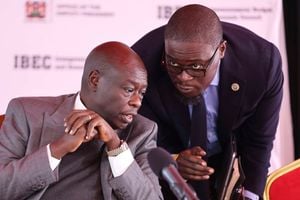Kenya’s judiciary bungles up one case after another

File | NATION
The Nairobi Law Courts. The domino effect of questionable calls by the lower courts is the release of criminals, what LRF’s Lenson Njogu calls “justice for the rich and injustice for the poor”
What you need to know:
- Collusion between court clerks, prosecutors and some magistrates means justice is never guaranteed
They pleaded their innocence. But during the hearing, a Narok court found Valentine Ondieki, Alex Opere and William Nyausi guilty of trafficking 753 kilos of marijuana. That earned them a life sentence.
On appeal, the jail term was dismissed. “This court wonders how the prosecution can establish that the appellants were traffickers… without the benefit of the actual drugs being produced in court,” Court of Appeal Judge L. Kimaru stated while releasing them on October 5, 2005.
“This court suggests that in cases such as this one, the trial court should not make an order for the destruction of the exhibits until the expiry of the 14 days so that it may be established if the convicted person has filed an appeal or not,” Judge Kimaru affirmed.
Yet this situation is hardly unusual. An analysis of over 30 appeal cases reveals irregularities at the lower courts, that include disappearance or destruction of exhibits before a case is closed, the inexplicable failure to summon witnesses key to a trial whose testimony would have changed the course of ruling, questionable ruling by trial magistrates, and failure by the state’s legal officers to defend the government against legal suits — decisions clouded by fraud, negligence and inertia.
Unqualified judicial officers prosecute cases, automatically rendering them a nullity. In other situations, the prosecution has lined up witnesses who turn hostile or give contradictory accounts, even as the investigating and/or arresting officers fail to appear in court.
Worse still, some court proceedings are handled in languages alien to suspects, yet the trial magistrate and prosecutor have no qualm about it.
“These malpractices have been around for awhile,” says Lenson Njogu, head of the Administration of Justice Programme, Legal Resources Foundation (LRF).
“It is not an isolated situation,” he says, in apparent reference to a case where a former minister was acquitted of fraud after the prosecution failed to call key witnesses.
What emerges is a situation in which deceitful prosecutors could be wedging themselves between Court of Appeal judges and trial magistrates.
And this has exposed the latter to ridicule from their seniors.
“The sentence imposed by the learned magistrate was an illegal sentence. (It) is thus, illegal in every respect…” Judge Jackton B. Ojwang’ once faulted the ruling of a lower court, in which a trafficker of two kilos of heroin (with a Sh2 million street value) had been given a suspended sentence rather than life in jail as stipulated in the law.
More apt was Justice Milton Asike Makhandia, on January 25, 2010. “It is very unlikely that a senior magistrate as the trial magistrate herein would have allowed witnesses to testify without being sworn in.” Swearing in witnesses is the course 101 in any law class, how a judicial officer would forget this is perplexing.
At the tail end of the fraud chain are court clerks, who falsify or “misplace” files.
For instance, the court couldn’t trace all documents (including recordings of the lower court) about a case involving a Somali national, Nisho Noor Isaack, who had been convicted by a Mandera court to serve 30 years for rape. Both the original and typed proceedings went missing, forcing the appellate judge, Mr Justice Makhandia, to free Isaack.
“Accordingly I set aside the conviction and sentences imposed by the lower court and discharge the appellant. The appellant is set free unless otherwise held in lawful custody,” he ordered on November 6, 2006.
The domino effect of questionable calls by the lower courts is the release of criminals, what LRF’s Njogu calls “justice for the rich and injustice for the poor”.
Implicitly, a prosecutor (police officers or state counsel) can boast to have the license to decide the ruling ahead of a hearing, according to a prominent lawyer who declined his name used for fear of antagonising the Judiciary.
Unfortunately, those unable to appeal, or have their appeals heard in time, find themselves imprisoned on flawed convictions.
“It is a big problem. In a good number of cases, it is deliberate,” says Mr Boniface Wanyoike, an official in charge of Access to Justice Programme, Catholic Church Peace and Justice Commission.
“The fault starts with the drafting of the charge sheet. It is done by officers who have little understanding of the law. When the case finally reaches the court, the magistrate is bound to throw it away because it’s defective.”
Wanyoike, who counsels remand prisoners in Trans Nzoia, Bungoma, and West Pokot counties, suspects that unscrupulous prosecutors could be colluding with complainants.
“I have witnessed situations where the court is told key witnesses disappeared and he/she is not around to testify, but immediately after the proceedings you meet the said witnesses within the court precincts just idling away.”
At the centre of this are prosecutors and in some cases trial magistrates.
In a case that involved a motor accident between a mini-bus and a lorry in which four people died, the prosecution appeared to work out a way to unhook the culprit — to shift the blame to the innocent party. The lorry driver was blamed for the accident caused by the minibus.
Indeed, the trial magistrate had found the lorry driver guilty of dangerous driving.
This was possible because the prosecution “suppressed” the testimony of some key witness, whose accounts would have impacted on the final judgment.
Appeal judge Makhandia called it a miscarriage of justice. While the lorry driver had gone out of his way to get witnesses to testify, the prosecution declined to call its own.
“The prosecution cannot be allowed to suppress evidence in their possession even if it is in favour of the accused.”
“Unfortunately this is what happened in the instant case. The investigating officer was selective in the evidence he wanted adduced before the court. There was evidence recorded from witnesses that was in favour of the appellant. The evidence was suppressed for no reason,” the judge noted.
Prosecutors blame the workload.
“Some of us are forced to serve more than one court; within a day you may have covered three different courts. When you take a month-leave, the cases halt to wait for you,” said a police prosecutor in Nairobi, annoyed that little is being done to deal with the problem.
“We are human too; we crumble under pressure and make small mistakes, just like anybody else.”
To an extent, he is right. Kenya has a backlog of one million cases, a pile occasioned by a shortage of top judicial officers. Some of the cases are about 30 years old, most drawn from motor accidents, according to a recent study by the Federation of Women Lawyers - Kenya (Fidak).
The country has one of the highest pile-ups of cases, perhaps only second to India, which has 20 million cases, according to a study by the UN Development Programme (UNDP).
Yet a comparative analysis of the two countries places Kenya in an even worse situation. For every 40 Kenyans, there’s a pending court file while India, with 1.2 billion people, has 60 people per file. Proportionately, India has fewer files.
The one million files have to be handled by 275 magistrates, 29 judges, and only 11 judges of the Court of Appeal. “This is a legal Mt Everest to climb. And you are expected to reach the peak in hours,” summed up a judge.
Yet, while it’s widely agreed that the backlog has occasioned inertia in judicial work, some rulings raise eyebrows. Indeed, failing to have the government chemist certify an illicit drug is in itself inexcusable.
Destroying an exhibit, such as marijuana, before the close of a case is questionable. Why would prosecutors decline to call key witnesses?
Why handle a case in a language alien to the suspect? Why fail to swear in witnesses?
More telling is the judgment involving the Sh2 million heroin haul seized from a woman at Jomo Kenyatta International Airport. The trial magistrate had imposed a 10-year suspended sentence. But the Director of Public Prosecutions argued that it was contrary to the law.
In his ruling, Judge Ojwang’ stated: “The sentence imposed by the learned magistrate was an illegal sentence. The sentence in question is thus, illegal in every respect…”
(He imposed a fine of Sh6 million or in default, serve eight years in imprisonment).
A Transparency International report observed in 2007, thus “In Kenya, the saying, “why hire a lawyer when you can buy a judge?” means that justice is for sale, and it is the rich and powerful who usually benefit.”
This was followed last year by a more quantified account, which placed Kenya’s Judiciary the 9th most corrupt public institution in the region.
The global corruption watchdog had analysed 108 institutions in Burundi, Kenya, Rwanda, Tanzania, and Uganda and published the outcome in what it called East Africa Bribery Index 2010.
At the national level, the Judiciary was the fourth most corrupt in Kenya — only better than Police, Ministry of State in charge of Defence, and Nairobi City Council. One in two people who sought the Judiciary has to part with a bribe — Sh11,000 on average.
In a presentation last year, James Sitienei, an attorney with the Kenya Anti-Corruption Commission, focused on corruption in the Judiciary (http://www.icgg.org/downloads/2010/sitienei.pdf). His talk was based on a self-audit of the Judiciary carried out in August 2005.
He said that out of 3,234 officers, consisting of 11 Judges of Appeal, 44 Judges of the High Court, 254 Magistrates, 15 Kadhis and 2,910 paralegals, 152 were implicated in corruption.
According to Sitienei, out of the 152 judicial officers implicated, 5 Court of Appeal Judges, 18 High Court Judges, 82 magistrates, and 43 paralegals, were implicated in judicial corruption, misbehaviour or want of ethics.
“Some of these things are deliberate, aimed at changing the course of a ruling. Some prosecutors liaise with complainants to ensure witnesses don’t appear, even delay summons,” says Wanyoike, who is currently handling a case where four people whose appeal succeeded, yet they are still in jail just because a judge has not signed the acquittal papers 40 days later. “Suspicion is more evident when the case involves a police officer.”
Collusion between suspects and/or complainants and judicial officers is hardly improbable, and it happens worldwide, even in the so-called developed world where the system is almost foolproof.
Corruption, it could be. However advocates of better governance say it may not be bribery.
“We must look at corruption from different angles, not necessarily bribery. These officers may have failed to do enough research (before a ruling), did not give themselves adequate time, failed to follow statute law, or didn’t use their discretion. It is not necessarily about money changing hands,” says LRF’s Lenson Njogu.
There are quite some progressive magistrates who do perfect work, he says. “But there are a few chosen ones, the old crop of magistrates, who have dirtied the profession.”




